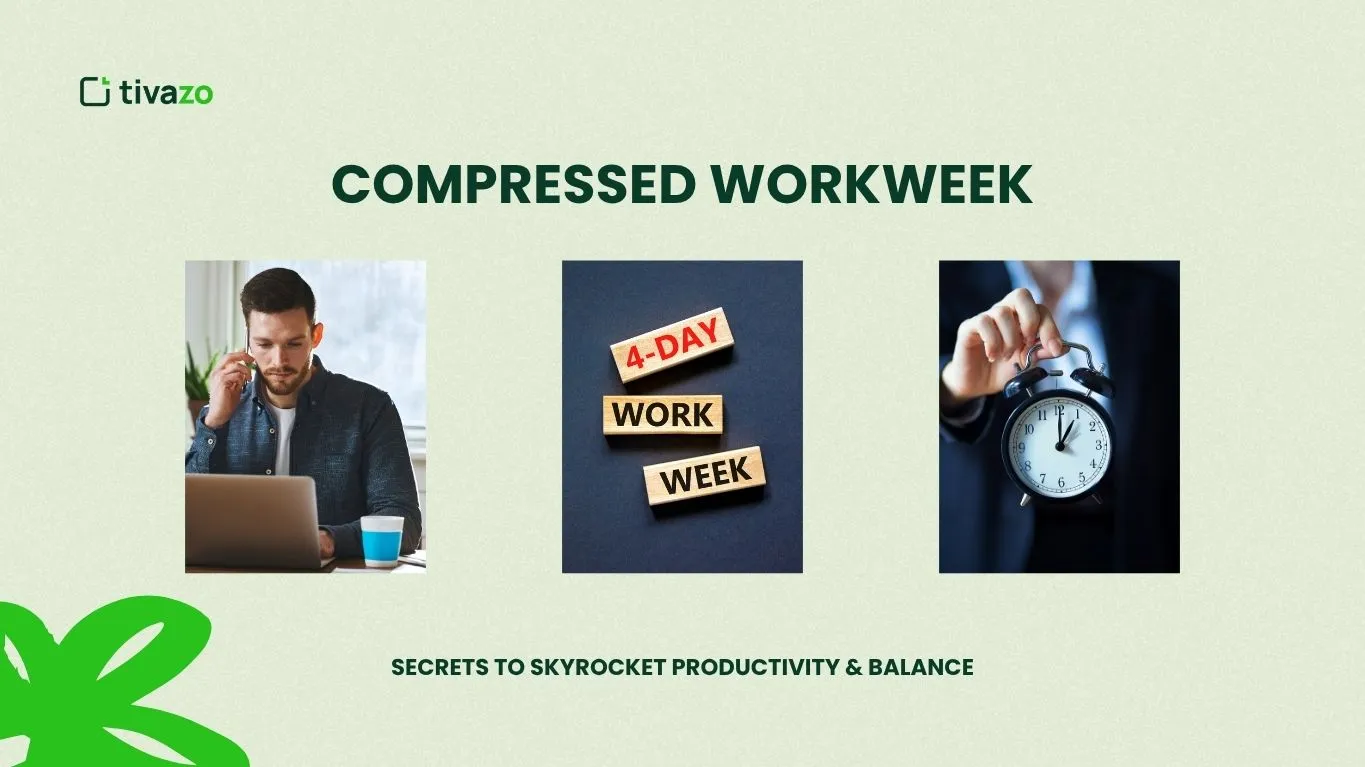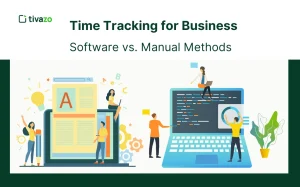The traditional 9-to-5, five-day workweek is starting to feel outdated in today’s fast-paced, digitally connected world. Enter the compressed workweek—a smarter, more flexible alternative where you complete full-time hours in fewer days.
What is a compressed workweek? It’s a flexible schedule where employees work the standard 35–40 hours in fewer than five days, most commonly through 4×10 or 9/80 formats. More businesses and employees are embracing this shift for better work-life balance, increased productivity, and reduced burnout. In this guide, we’ll unlock 5 must-know secrets to help you succeed with a compressed workweek and transform how you work, starting now.
Key Highlights:
- Calculation of Compressed Workweek
- 5 Must-Know Secrets for Compressed Workweek Success
- Pros and Cons of a Compressed Work Schedule
- Best Compressed Workweek Schedule Examples
What Is a Compressed Workweek?
A compressed workweek is a flexible work schedule in which employees complete their regular full-time hours (which usually range between 35 to 40 hours per week) in less than five days. Although the total number of hours worked per week is the standard, the compressed workweek reduces the number of workdays.
The most common layouts for compressed workweeks are:
- 4×10 – Four 10-hour workdays (Monday to Thursday) or 4×10 for four days a week.
- 9/80 – Nine 9-hour days and a day of 8 hours. Because 80 hours are being worked over two weeks, the employee receives every other Friday off.
Compressed workweeks are advantageous for both employees and employers as compressed workweeks produce longer weekends, less time commuting, better work-life balance, and all the while allowing companies to maintain productivity or employee satisfaction. This may be particularly beneficial in positions where work can be interrupted, and fewer interruptions result in better work products.
How to Calculate a Compressed Workweek?
To calculate a compressed work week, divide your total work hours per week (usually 40 hours) by the number of days you are going to work.
- 4×10 schedule: 40 ÷ 4 = 10-hour workdays
A 9/80 work schedule is to plan to work eight 9-hour days in two weeks and one additional 8-hour day.
5 Must-Know Secrets for Compressed Workweek Success
5 Must-Know Secrets for Compressed Workweek Success are:
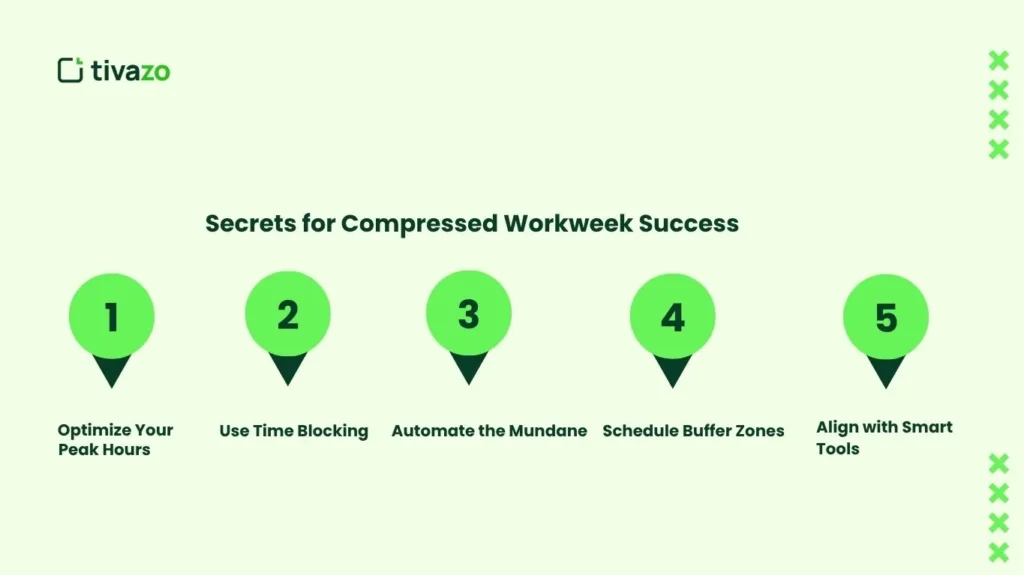
1. Optimize Your Peak Hours
People have innate energy patterns, and all start and finish work at different times of the day. Some people are productive in the morning, some people are productive in the afternoon, and some are night owls. Figure out your best hours to be productive and put your biggest or most taxing tasks in those windows.
This will enable more to be done in less time and reduce the fatigue that comes from working longer hours. Whether you’re a morning person or a night owl, the technique here is to protect your deep work windows in order to flourish in a compressed work schedule.
2. Use Time Blocking
When working longer hours, it is all too easy to lose track of time or end up in a multitasking pattern. Time blocking is perfect to help structure your day into blocks of focus with scheduled breaks. For example, look at the Pomodoro technique. 25 minutes of pure focus and then a 5-minute break.
Using timed blocks to focus on work with scheduled breaks can help ensure that you maintain energy and attention throughout the day. These blocks can keep you sharp mentally and help to avoid burnout in your 10-hour work shift.
3. Automate the Mundane
Much of your work doesn’t require your full attention. You can save time and energy by automating mundane tasks or tasks that aren’t as impactful. There are several options you can use to automatically manage certain work processes. Some of these options include filters in your email, calendar scheduling tools, documents based on a template, or even AI to automate meeting note-taking.
Automating small portions of your workday, especially in a compressed workweek, will save you several hours a week that you can use to focus on big-picture thinking and other more strategic types of thinking. It’s important to cut out unnecessary manual tasks where you can since every minute of your day is valuable.
4. Schedule Buffer Zones
Without short rest periods, your body and mind can easily become exhausted on longer workdays. That’s why it’s important to build in buffer zones and intentional gaps between meetings and tasks to give your brain an intentional opportunity to rejuvenate. For example, a 10- to 15-minute period of rest or rest between video calls or deep work is enough to reset your brain and give your body a brief stretch, a snack, or prevent decision fatigue.
These brief moments of recovery can have a significant impact on job performance and mental clarity over longer work shifts.
5. Align with Smart Tools
Digital tools can influence the success of your compressed workweek. For example, Tivazo helps track hours and productivity in real time. Slack can be used for asynchronous communication, which keeps your team aligned despite working on a staggered schedule. Notion helps document processes and project progression.
The key is to create a digital ecosystem that promotes autonomy, transparency, and collaboration so everyone has access and is aligned as to when everyone is available to work.
What Makes a Compressed Workweek Successful?
A compressed workweek can yield major advantages, but only if it is intentional. It’s not just about cramming 40 hours into fewer days; it’s about a structure that creates a way for teams and team members to focus, collaborate, and care for their well-being. If teams don’t have healthy, intentional strategies to support their work, they may burn out or find themselves out of sync with their team. The most productive compressed schedules effectively blend productivity with flexibility by following three keys:
- Time management – Block time, prioritize objectives, and focus time
- Team coordination – Schedule alignment, communicate availability, and updates asynchronously
- Well-being practices – Take breaks, don’t overwork, and respect your time
When structured well, compressed workweeks boost both output and morale.
Pros and Cons of a Compressed Work Schedule
Pros and Cons of a Compressed Work Schedule are:
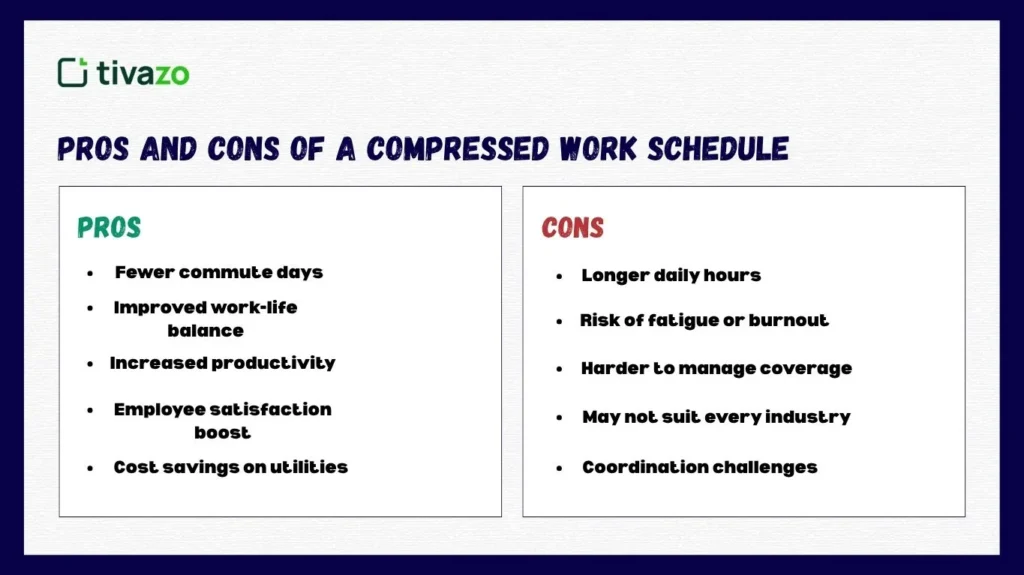
Coordinating Teams With Staggered Schedules
When coordinating teams on staggered compressed schedules, coordinating effectively means communicating clearly and planning smartly. Start with a shared calendar system like Google or Outlook so everyone is aware of when people are working, so you can avoid gaps or overlaps in time covered. Use asynchronous communication tools like Slack and Notion to share updates and collaborate; they are not dependent on everyone being present at the same time. And remember to establish core sync hours for live meetings to retain a sense of connection and team alignment.
Identifying rotating coverage assignments to ensure important tasks or support are always covered is also important and can be coupled with your calendar tool, so that it’s all fairly distributed. Another helpful tool is establishing a visual coverage map to identify team availability across time zones so that it becomes clearer for a manager to plan operational handoffs and keep workflows easy.
With transparency and the appropriate tools, staggered work schedules will provide a coordinated, productive advantage instead of a coordinating headache.
Best Compressed Workweek Schedule Examples
Not every compressed workweek can take the same format. The ideal compressed workweek structure will depend on your industry and how many employees are on your team, as well as customer demand and employee preferences. Some industries require around-the-clock coverage, while others may be comfortable with extended weekends or alternating days off.
Regardless of whether your business operates within tech, healthcare, education, or remote services, one or more of these models may find their place somewhere in your schedule to attract workers through flexibility without losing productivity. Below are three compressed workweek models that are frequently used, which make room for flexibility without sacrificing productivity.
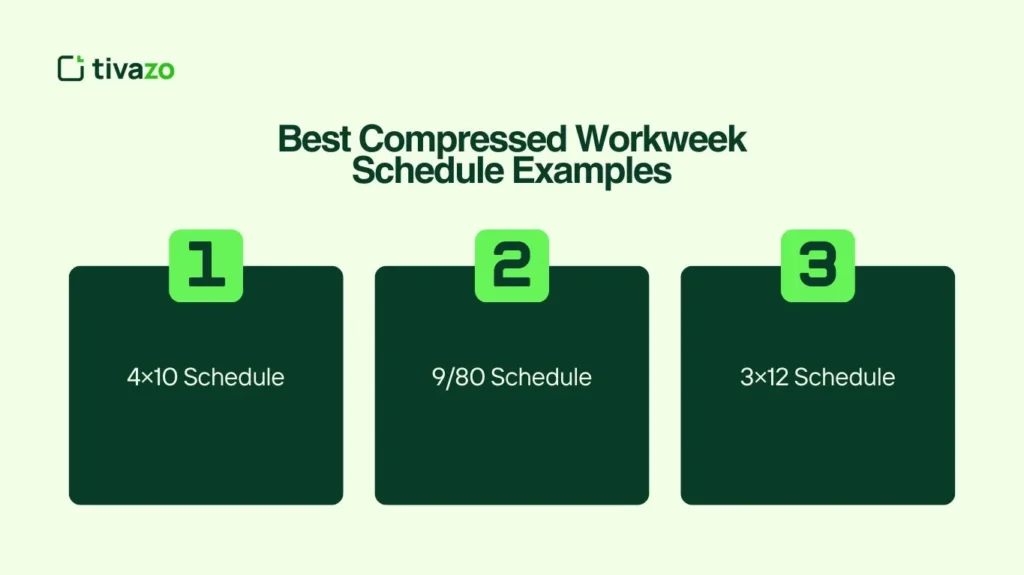
- 4×10 Schedule: Monday through Thursday, 10 hours per day.
- 9/80 Schedule: 80 hours spread out over 9 days with every other Friday off.
- 3×12 Schedule: Three 12-hour shifts per week (often found in healthcare).
Each model works for differing structures based on customer coverage, the size of the team, and workload.
Avoiding Burnout in a Compressed Workweek
A long day at work in a compressed schedule can add to the risk of employee burnout if we are not careful. Managing your energy and focus is essential in completing your work and remaining productive. Scheduling planned intervals throughout the day is vital, even if they are short, such as a few minutes to stretch, hydrate, or simply step away from your screen for a moment. Each of these can provide a resetting opportunity for your mind and body, resulting in increased energy and productive recovery time. Limiting screen time on your devices after work will also support your mental health and help you sleep better.
When working, practicing only one task at a time is preferable to multitasking, particularly during your peak productivity hours, so that you have an opportunity for a deep and reduced-stress work period. Another potential tool is using wellness products like Tivazo’s Pomodoro tracker, allowing you to track micro-moments of rest and also engage in moments of rejuvenation after forms of intense sessions on work projects. With the combination of these habits, you will be able to sustain energy and avoid exhaustion over longer shifts of work.
Payroll and HR Adjustments for Compressed Workweeks
Moving to a compressed workweek can have payroll and human resource implications, primarily for hourly employees. Employees who work compressed workweeks are working longer hours yet fewer days, and companies need to ensure payroll systems accurately track actual hours worked for laws and to avoid costly overtime mistakes.
Human Resources will also need to explain and, if necessary, adapt policies related to paid time off (PTO), holiday accrual and scheduling to avoid any adverse impact on employees and to reinforce equity about shifts in unpaid time off policies as compressed workweeks do not impact the schedule status of unpaid time off, but could affect how it is accrued. Updating employment contracts and indicating a new work schedule & documentation help prevent confusion and streamline onboarding for both new employees and current employees.
- Adjust time-tracking systems
- Align PTO and holiday accrual policies
- Update employment contracts and policies
Documentation clears up confusion, onboarding will flow smoothly, and there will be no errors in any payroll processing.
Who Should Avoid a Compressed Work Schedule?
Compressed workweeks offer a number of advantages, but they are not good for everyone. For example, jobs that require short bursts of high physical activity could get tiring and become unsafe if they are longer shifts. Additionally, individuals who have an inherent rhythm of productivity and performance that peaks at strange times may continue to be challenged to work longer days. Similarly, staff with specific medical conditions can find extended work periods to be surprisingly exhausting, and at times detrimental to their recovery and health.
Finally, parents or caregivers who must take care of their dependent individual during lunch may find compressed schedules impractical for day-to-day realities. Organizations will need to think about as many different potential hybrid/remote work situations articulated above, and weigh their work plans against the specific needs of their employees.
Conclusion: Why It’s Time to Try a Compressed Workweek
Compressed workweeks can be more than a workplace fad—they are a documented method for improving modern productivity. By redefining how you structure your workweek, you get your time back for the things that matter most to you, while maintaining your performance levels. When given flexibility, employees state they are more focused, have better morale, and experience less burnout.
Whether you have been struggling in the trenches of the five-day workweek or not, now is the time to effect change. You don’t even need to rely on an HR-approved plan to get started on compressing your workweek, even trying 4×10 with accurate time tracking can completely change your workflow.
Pick one secret from this guide to start with—optimize your peak hours or try a new tool for an everyday task. The future of work is flexible, make it flexible for you!
FAQs
What are the disadvantages of compressed workweeks?
Longer days, more fatigue, harder childcare, and scheduling conflicts.
What does CWW mean?
CWW = Compressed Workweek (full hours in fewer days).
What makes a compressed workweek work?
Clear schedules, smart tools, and regular breaks.
What are the benefits of a compressed workweek?
Key benefits include better work-life balance, higher productivity, fewer commutes, and increased employee satisfaction. It also supports mental well-being.
How can you implement a 4-day compressed workweek?
Start with a pilot, define working hours clearly, train managers, and use tools like Tivazo to track productivity and ensure fairness.
